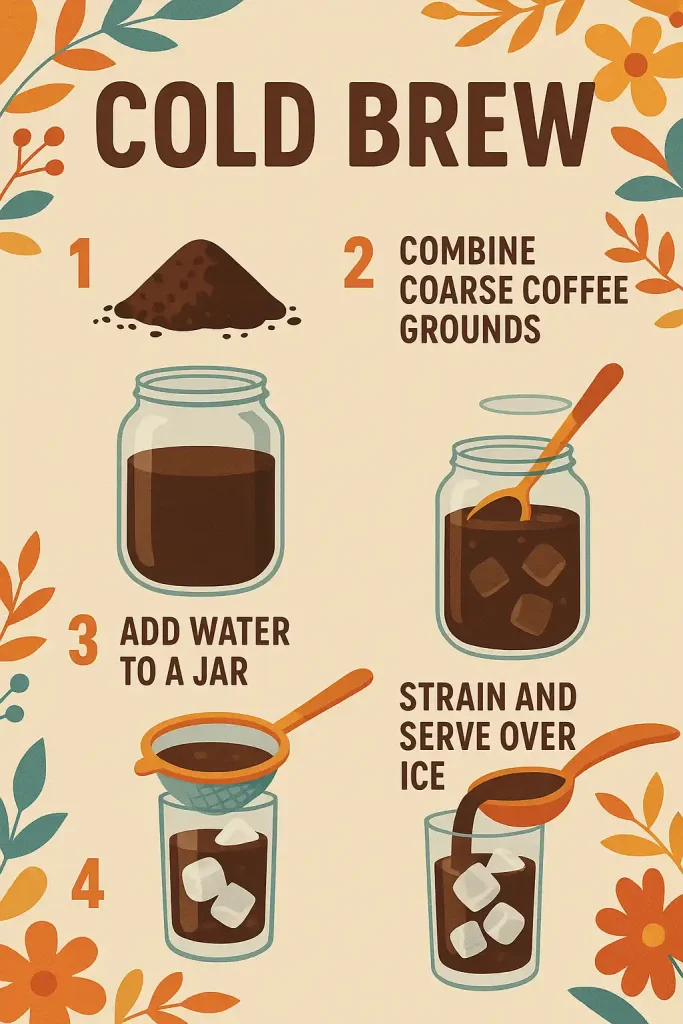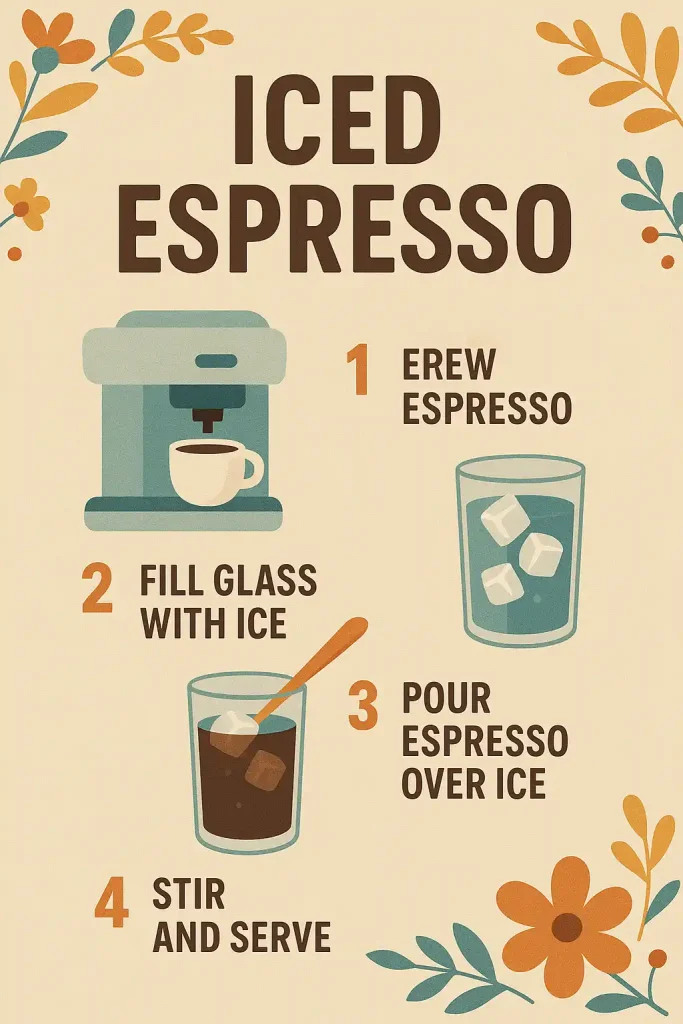On a hot day, getting a cold, refreshing cup of coffee is great. Many options are available when choosing the right cold flavor. Here, I discuss and compare three high-quality, most-consumed flavors: iced espresso, iced coffee, and cold brew.
In fact, it’s a battle of three highly caffeinated drinks. You can enjoy strong, robust, caffeinated drinks by picking any of these flavors.
Although all these flavors taste cold and refreshing, they differ in ingredients, brewing method, and strength.
Iced espresso: This beverage offers a strong, refreshing flavor with an espresso shot and iced cubes.
Iced Coffee: Another highly caffeinated drink, it includes brewed coffee and ice cubes.
Cold brew: It needs to steep ground coffee in cold water for 12 to 24 hours.
Now let’s dive into the details.
Cold brew vs iced coffee vs iced espresso: what sets their flavors apart?
Before brewing any of these flavors, understanding the real difference will help to make the real taste and texture.

Which flavor has fewer ingredients?
All three coffee flavors significantly differ in ingredients. One uses espresso, the other adds brewed coffee, and the third adds steeped ground coffee. All three add ice to make it cold.
Check the ingredients in detail.
- Cold brew ingredients
This flavor is smooth and low-acid, with iced cubes, created by steeping coarsely ground coffee in cold water for a long time.
It’s less bitter than traditional iced coffee and naturally sweeter.
- Iced coffee
It requires two tablespoons of medium to dark roast coffee beans and ice cubes, with a highly caffeinated yet refreshing flavor.
An iced coffee is first brewed hot and then allowed to cool before adding ice cubes.
- Iced espresso ingredients
Unlike cold brew and iced coffee, the iced espresso consists of espresso shots and ice cubes.
This cold flavor is strong and bitter.
Check the difference between cold brew vs breve.
Cold brew vs iced coffee vs iced espresso: What is the difference in brewing method?
Interesting that all three have different brewing methods.
Cold brew brewing method
It takes the longest to make this flavor.
- Cold brew needs coarsely ground coffee beans to be steeped in cold water for 12 to 24 hours.
- Pick coarse-ground coffee beans.
- Add cold water; the ratio of water to coffee beans should be 1:4.
- Put it in the fridge for 12 hours or for a longer time.
- After the steeping, filter it using a coffee filter.
- Add ice cubes to it.

Iced Coffee Brewing Method
An Iced coffee is brewed hot, and then ice cubes are added to cool it down.
- You can use a French press, drip brewer, or any other brewing method.
- The coffee-to-water ratio should be 1:5 or 1:6.
- Pick a glass and half fill it with ice cubes.
- When the brewed coffee is slightly chilled, pour it over the glass of ice cubes.
- You can add sweet syrup or other flavors to it.
Iced espresso brewing method
A strong, cold flavor with iced cubes makes it a robust yet cold coffee flavor.
- Brew two shots of espresso
- Add ice cubes to the glass
- Pour espresso shots into the glass
- Optionally, add milk or sugar to make it less intense and sweeter.

Do they serve in different cup sizes?
Yes, they differ in serving size. However, you can make any flavor according to your preference and size.
- Iced coffee serving size
Unlike a brewed hot coffee, iced coffee is served in a large glass. However, the cup size varies from 12oz. to 20 oz.
An ideal size for an iced coffee should be 16 ounces (480ml).
- Cold brew serving size
Cold brew is typically also served in 12-oz to 20 cup sizes. However, 16 ounces (480ml) is the standard serving size.
- Iced espresso serving size
Unlike iced coffee and cold brew, the iced espresso is served in a smaller cup.
An iced espresso is served in a 2 to 3-oz (60 to 80ml) size.
Which flavor contains more caffeine?
All three flavors contain of high caffeine level. However, iced espresso with a small serving size has less caffeine than iced coffee and cold brew.
| Drink | Typical Serving Size | Caffeine Content | Caffeine per oz. (approx.) |
|---|---|---|---|
| Cold Brew | 12 oz (355 ml) | 150–210 mg | 12.5–17.5 mg/oz |
| Iced Coffee | 12 oz (355 ml) | 120–140 mg | 10–11.7 mg/oz |
| Iced Espresso | 2–4 oz (1–2 shots) | 63–125 mg | 31.5–62.5 mg/oz |
- Cold brew Caffeine
The caffeine level depends on the size of the glass. Cold brew consists of slightly more caffeine than iced coffee.
A glass of 12 ounces of cold brew has around 150 to 200 mg of caffeine.
- Iced coffee Caffeine
An iced coffee of 12 oz. size consists of 130 to 150 mg of caffeine.
- Iced espresso caffeine
An iced espresso with an espresso shot and iced cubes consists of 63 mg of caffeine.
Cold brew vs iced coffee vs iced espresso: Which flavor tastes the strongest?
These flavors contain high caffeine, which means they taste bold and bitter.
Iced Coffee Taste
Because it’s brewed hot and then cooled, the oils and acids are more noticeable than in cold brew.
However, iced coffee is less intense and bitter than iced espresso.
Cold Brew taste
Cold brew tastes less intense, smoother, and less acidic compared to iced coffee. However, with a higher caffeine kick, a cold brew tastes robust.
Also, this flavor is naturally slightly sweeter due to the prolonged steeping process.
Iced Espresso taste
Iced espresso has a bold, intense, and concentrated flavor. An espresso-based based tastes much stronger than cold brew and iced coffee. You can call it an iced shot of traditional espresso.
Shaken espresso vs latte vs cold brew: Check Differences?
Final Thoughts: Which cold flavor to pick?
All three cold flavors, refreshingly delicious. It purely depends on what you prefer. Here is my pick for you.
Cold brew: if you prefer slightly sweet and less intense. A great drink if you can brew it at home. However, you can order a cold brew from your nearest coffee shop.
Iced coffee: If you love classic coffee flavor, with a slightly bolder taste, pick iced coffee. Also, it is much easier and quicker to brew.
Iced espresso: Well, if you like espresso, you can make it cold by adding ice cubes. Also, a fan of espresso would love to make it cold rather than go for traditional coffee or cold brew.

